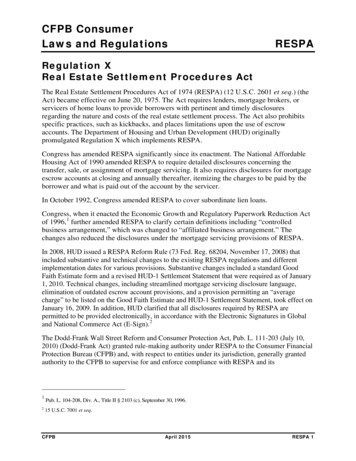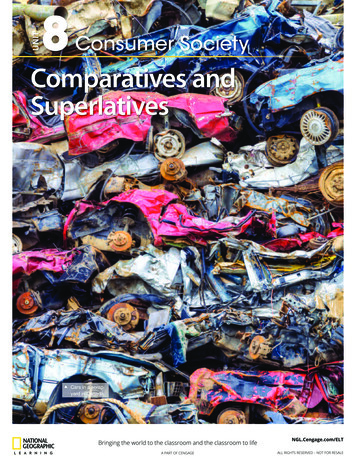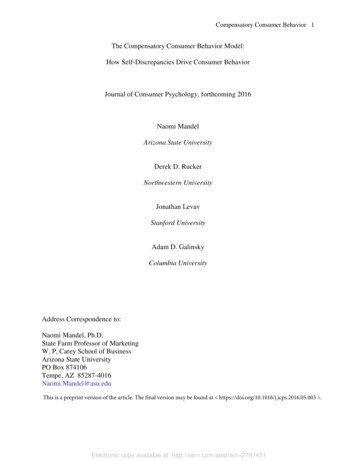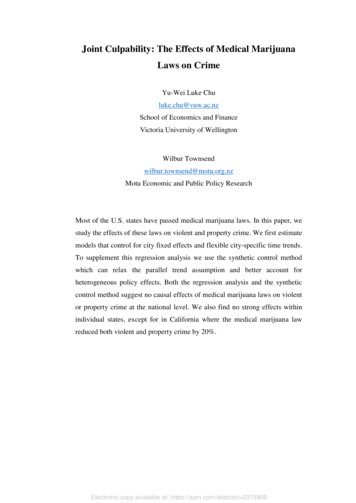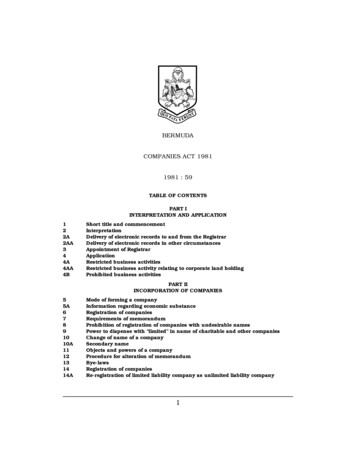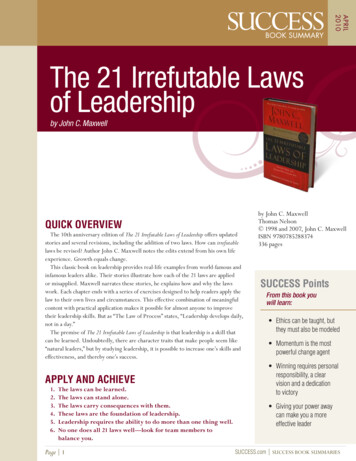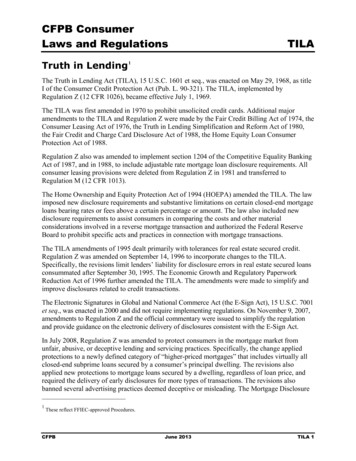
Transcription
CFPB ConsumerLaws and RegulationsTILATruth in Lending 1The Truth in Lending Act (TILA), 15 U.S.C. 1601 et seq., was enacted on May 29, 1968, as titleI of the Consumer Credit Protection Act (Pub. L. 90-321). The TILA, implemented byRegulation Z (12 CFR 1026), became effective July 1, 1969.The TILA was first amended in 1970 to prohibit unsolicited credit cards. Additional majoramendments to the TILA and Regulation Z were made by the Fair Credit Billing Act of 1974, theConsumer Leasing Act of 1976, the Truth in Lending Simplification and Reform Act of 1980,the Fair Credit and Charge Card Disclosure Act of 1988, the Home Equity Loan ConsumerProtection Act of 1988.Regulation Z also was amended to implement section 1204 of the Competitive Equality BankingAct of 1987, and in 1988, to include adjustable rate mortgage loan disclosure requirements. Allconsumer leasing provisions were deleted from Regulation Z in 1981 and transferred toRegulation M (12 CFR 1013).The Home Ownership and Equity Protection Act of 1994 (HOEPA) amended the TILA. The lawimposed new disclosure requirements and substantive limitations on certain closed-end mortgageloans bearing rates or fees above a certain percentage or amount. The law also included newdisclosure requirements to assist consumers in comparing the costs and other materialconsiderations involved in a reverse mortgage transaction and authorized the Federal ReserveBoard to prohibit specific acts and practices in connection with mortgage transactions.The TILA amendments of 1995 dealt primarily with tolerances for real estate secured credit.Regulation Z was amended on September 14, 1996 to incorporate changes to the TILA.Specifically, the revisions limit lenders’ liability for disclosure errors in real estate secured loansconsummated after September 30, 1995. The Economic Growth and Regulatory PaperworkReduction Act of 1996 further amended the TILA. The amendments were made to simplify andimprove disclosures related to credit transactions.The Electronic Signatures in Global and National Commerce Act (the E-Sign Act), 15 U.S.C. 7001et seq., was enacted in 2000 and did not require implementing regulations. On November 9, 2007,amendments to Regulation Z and the official commentary were issued to simplify the regulationand provide guidance on the electronic delivery of disclosures consistent with the E-Sign Act.In July 2008, Regulation Z was amended to protect consumers in the mortgage market fromunfair, abusive, or deceptive lending and servicing practices. Specifically, the change appliedprotections to a newly defined category of “higher-priced mortgages” that includes virtually allclosed-end subprime loans secured by a consumer’s principal dwelling. The revisions alsoapplied new protections to mortgage loans secured by a dwelling, regardless of loan price, andrequired the delivery of early disclosures for more types of transactions. The revisions alsobanned several advertising practices deemed deceptive or misleading. The Mortgage Disclosure1These reflect FFIEC-approved Procedures.CFPBJune 2013TILA 1
CFPB ConsumerLaws and RegulationsTILAImprovement Act of 2008 (MDIA) broadened and added to the requirements of the Board’s July2008 final rule by requiring early truth-in-lending disclosures for more types of transactions andby adding a waiting period between the time when disclosures are given and consummation ofthe transaction. In 2009, Regulation Z was amended to address those provisions. The MDIA alsorequires disclosure of payment examples if the loan’s interest rate or payments can change, aswell as disclosure of a statement that there is no guarantee the consumer will be able to refinancein the future. In 2010, Regulation Z was amended to address these provisions, which becameeffective on January 30, 2011.In December 2008, the Board adopted two final rules pertaining to open-end (not home-secured)credit. The first rule involved Regulation Z revisions and made comprehensive changes applicableto several disclosures required for: applications and solicitations, new accounts, periodicstatements, change in terms notifications, and advertisements. The second was a rule publishedunder the Federal Trade Commission (FTC) Act and was issued jointly with the Office of ThriftSupervision and the National Credit Union Administration. It sought to protect consumers fromunfair acts or practices with respect to consumer credit card accounts. Before these rules becameeffective, however, the Credit Card Accountability Responsibility and Disclosure Act of 2009(Credit CARD Act) amended the TILA and established a number of new requirements for openend consumer credit plans. Several provisions of the Credit CARD Act are similar to provisions inthe Board’s December 2008 TILA revisions and the joint FTC Act rule, but other portions of theCredit CARD Act address practices or mandate disclosures that were not addressed in these rules.In light of the Credit CARD Act, the Board, NCUA, and OTS withdrew the substantiverequirements of the joint FTC Act rule. On July 1, 2010, compliance with the provisions of theBoard’s rule that were not impacted by the Credit CARD Act became effective.The Credit CARD Act provisions became effective in three stages. The provisions effective first(August 20, 2009) required creditors to increase the amount of notice consumers receive before therate on a credit card account is increased or a significant change is made to the account’s terms.These amendments also allowed consumers to reject such increases and changes by informing thecreditor before the increase or change goes into effect. The provisions effective next (February 22,2010) involved rules regarding interest rate increases, over-the-limit transactions, and studentcards. Finally, the provisions effective last (August 22, 2010) addressed the reasonableness andproportionality of penalty fees and charges and re-evaluation of rate increases.In 2009, Regulation Z was amended following the passage of the Higher Education OpportunityAct (HEOA) by adding disclosure and timing requirements that apply to lenders making privateeducation loans.In 2009, the Helping Families Save Their Homes Act amended the TILA to establish a newrequirement for notifying consumers of the sale or transfer of their mortgage loans. Thepurchaser or assignee that acquires the loan must provide the required disclosures no later than30 days after the date on which it acquired the loan.In 2010, the Board further amended Regulation Z to prohibit payment to a loan originator that isbased on the terms or conditions of the loan, other than the amount of credit extended. Theamendment applies to mortgage brokers and the companies that employ them, as well as toCFPBJune 2013TILA 2
CFPB ConsumerLaws and RegulationsTILAmortgage loan officers employed by depository institutions and other lenders. In addition, theamendment prohibits a loan originator from directing or “steering” a consumer to a loan that isnot in the consumer’s interest to increase the loan originator’s compensation.The Dodd-Frank Wall Street Reform and Consumer Protection Act of 2010 (Dodd-Frank Act)amended the TILA to include several provisions that protect the integrity of the appraisal processwhen a consumer’s home is securing the loan. The rule also requires that appraisers receivecustomary and reasonable payments for their services. The appraiser and loan originatorcompensation requirements had a mandatory compliance date of April 6, 2011.The Dodd-Frank Act granted rulemaking authority under the TILA to the Consumer FinancialProtection Bureau (CFPB). Title XIV of the Dodd-Frank Act included a number of amendmentsto TILA, and in 2013, the CFPB issued rules to implement them. Prohibitions on mandatoryarbitration, waivers of consumer rights, as well as requirements that lengthen the time creditorsmust maintain an escrow account for higher-priced mortgage loans, are effective June 1, 2013.CFPB issued rules prohibiting certain single premium credit insurance financing, but has delayedthe effective date until January 2014. The remaining amendments to Regulation Z, whichinclude establishing ability to pay requirements for mortgage loans, establishing appraisalrequirements for higher-priced mortgage loans, revising and expanding the test for high-costmortgage loans as well as imposing additional restrictions on those loans, establishingrequirements for servicers of mortgage loans, and refining loan originator compensation rulesand loan origination qualification standards are effective in January 2014. The amendments alsoestablished new record retention requirements for certain provisions of TILA.Format of Regulation ZThe rules creditors must follow differ depending on whether the creditor is offering open-end credit,such as credit cards or home-equity lines, or closed-end credit, such as car loans or mortgages.Subpart A (sections 1026.1 through 1026.4) of the regulation provides general information thatapplies to open-end and closed-end credit transactions. It sets forth definitions and stipulateswhich transactions are covered and which are exempt from the regulation. It also contains therules for determining which fees are finance charges.Subpart B (sections 1026.5 through 1026.16) relates to open-end credit. It contains rules onaccount-opening disclosures and periodic statements. It also describes special rules that apply tocredit card transactions, treatment of payments and credit balances, procedures for resolving creditbilling errors, annual percentage rate calculations, rescission requirements, and advertising.Subpart C (sections 1026.17 through 1026.24) relates to closed-end credit. It contains rules ondisclosures, treatment of credit balances, annual percentage rate calculations, rescissionrequirements, and advertising.Subpart D (sections 1026.25 through 1026.30) contain rules on oral disclosures, disclosuresin languages other than English, record retention, effect on state laws, state exemptions, andrate limitations.CFPBJune 2013TILA 3
CFPB ConsumerLaws and RegulationsTILASubpart E (sections 1026.31 through 1026.45) contains special rules for certain mortgagetransactions. It contains rules on certain disclosures and provides limitations for loans that have ratesor fees above specified amounts, and restricts certain terms for home equity plans. It containsrequirements for reverse mortgage transactions. It provides for additional prohibitions for specificacts and practices in connection with an extension of credit secured by a dwelling. It contains ruleson valuation independence, loan originator compensation in transactions secured by a dwelling, andloan originator qualification standards requirements for certain types of loans secured by a dwelling.Subpart F (sections 1026.46 through 1026.48) relates to private education loans. It contains ruleson disclosures, limitations on changes in terms after approval, the right to cancel the loan, andlimitations on co-branding in the marketing of private education loans.Subpart G (sections 1026.51 through 1026.60) relates to credit card accounts under an open-end(not home-secured) consumer credit plan (except for § 1026.57(c), which applies to all open-endcredit plans). This subpart contains rules regarding credit and charge card application andsolicitation disclosures. It also contains rules on evaluation of a consumer’s ability to make therequired payments under the terms of an account, limits the fees that a consumer can be required topay, and contains rules on allocation of payments in excess of the minimum payment. It also setsforth certain limitations on the imposition of finance charges as the result of a loss of a graceperiod, and on increases in annual percentage rates, fees, and charges for credit card accounts,including the reevaluation of rate increases. This subpart prohibits the assessment of fees orcharges for over-the-limit transactions unless the consumer affirmatively consents to the creditor’spayment of over-the-limit transactions. This subpart also sets forth rules for reporting andmarketing of college student open-end credit. Finally, it sets forth requirements for the Internetposting of credit card accounts under an open-end (not home-secured) consumer credit plan.Several appendices contain information such as the procedures for determinations about statelaws, state exemptions and issuance of official interpretations, special rules for certain kinds ofcredit plans, and the rules for computing annual percentage rates in closed-end credit transactionsand total-annual-loan-cost rates for reverse mortgage transactions.Official interpretations of the regulation are published in a commentary. Good faith compliance withthe commentary protects creditors from civil liability under the TILA. In addition, the commentaryincludes more detailed information on disclosures or other actions required of creditors. It is virtuallyimpossible to comply with Regulation Z without reference to and reliance on the commentary.NOTE: The following narrative does not discuss all the sections of Regulation Z, but ratherhighlights only certain sections of the regulation and the TILA.CFPBJune 2013TILA 4
CFPB ConsumerLaws and RegulationsTILASubpart A – GeneralPurpose of the TILA and Regulation ZThe TILA is intended to ensure that credit terms are disclosed in a meaningful way so consumerscan compare credit terms more readily and knowledgeably. Before its enactment, consumerswere faced with a bewildering array of credit terms and rates. It was difficult to compare loansbecause they were seldom presented in the same format. Now, all creditors must use the samecredit terminology and expressions of rates. In addition to providing a uniform system fordisclosures, the act: Protects consumers against inaccurate and unfair credit billing and credit card practices; Provides consumers with rescission rights; Provides for rate caps on certain dwelling-secured loans; Imposes limitations on home equity lines of credit and certain closed-end home mortgages;and Delineates and prohibits unfair or deceptive mortgage lending practices.The TILA and Regulation Z do not, however, tell financial institutions how much interest theymay charge or whether they must grant a consumer a loan.Summary of Coverage Considerations –Sections 1026.1 & 1026.2Lenders must carefully consider several factors when deciding whether a loan requires Truth inLending disclosures or is subject to other Regulation Z requirements. The coverageconsiderations under Regulation Z are addressed in more detail in the commentary to RegulationZ. For example, broad coverage considerations are included under section 1026.1(c) of theregulation and relevant definitions appear in section 1026.2.Exempt Transactions – Section 1026.3The following transactions are exempt from Regulation Z: Credit extended primarily for a business, commercial, or agricultural purpose; Credit extended to other than a natural person (including credit to government agencies orinstrumentalities);CFPBJune 2013TILA 5
CFPB ConsumerLaws and RegulationsTILA Credit in excess of an annually adjusted threshold not secured by real property or by personalproperty used or expected to be used as the principal dwelling of the consumer; 2 Public utility credit; Credit extended by a broker-dealer registered with the Securities and Exchange Commission(SEC) or the Commodity Futures Trading Commission (CFTC), involving securities orcommodities accounts; Home fuel budget plans not subject to a finance charge; and Certain student loan programs.However, when a credit card is involved, generally exempt credit (e.g., business purpose credit)is subject to the requirements that govern the issuance of credit cards and liability for theirunauthorized use. Credit cards must not be issued on an unsolicited basis and, if a credit card islost or stolen, the cardholder must not be held liable for more than 50 for the unauthorized useof the card. (Comment 3-1)When determining whether credit is for consumer purposes, the creditor must evaluate all of thefollowing: Any statement obtained from the consumer describing the purpose of the proceeds.o For example, a statement that the proceeds will be used for a vacation trip would indicatea consumer purpose.o If the loan has a mixed-purpose (e.g., proceeds will be used to buy a car that will be usedfor personal and business purposes), the lender must look to the primary purpose of theloan to decide whether disclosures are necessary. A statement of purpose from theconsumer will help the lender make that decision.o A checked box indicating that the loan is for a business purpose, absent anydocumentation showing the intended use of the proceeds could be insufficient evidencethat the loan did not have a consumer purpose. The consumer’s primary occupation and how it relates to the use of the proceeds. The higherthe correlation between the consumer’s occupation and the property purchased from the loanproceeds, the greater the likelihood that the loan has a business purpose. For example,proceeds used to purchase dental supplies for a dentist would indicate a business purpose.2The Dodd-Frank Act requires that this threshold be adjusted annually by any annual percentage increase in theConsumer Price Index for Urban Wage Earners and Clerical Workers (CPI-W). Accordingly, based on the annualpercentage increase in the CPI-W as of June 1, 2012, the exemption threshold increased from 51,800 to 53,000,effective January 1, 2013.CFPBJune 2013TILA 6
CFPB ConsumerLaws and RegulationsTILA Personal management of the assets purchased from proceeds. The lower the degree of theborrower’s personal involvement in the management of the investment or enterprisepurchased by the loan proceeds, the less likely the loan will have a business purpose. Forexample, money borrowed to purchase stock in an automobile company by an individual whodoes not work for that company would indicate a personal investment and a consumerpurpose. The size of the transaction. The larger the size of the transaction, the more likely the loan willhave a business purpose. For example, if the loan is for a 5,000,000 real estate transaction,that might indicate a business purpose. The amount of income derived from the property acquired by the loan proceeds relative tothe borrower’s total income. The lesser the income derived from the acquired property, themore likely the loan will have a consumer purpose. For example, if the borrower has anannual salary of 100,000 and receives about 500 in annual dividends from the acquiredproperty, that would indicate a consumer purpose.All five factors must be evaluated before the lender can conclude that disclosures are notnecessary. Normally, no one factor, by itself, is sufficient reason to determine the applicability ofRegulation Z. In any event, the financial institution may routinely furnish disclosures to theconsumer. Disclosure under such circumstances does not control whether the transaction iscovered, but can assure protection to the financial institution and compliance with the law.CFPBJune 2013TILA 7
CFPB ConsumerLaws and RegulationsTILACoverage Considerations under Regulation ZIs thepurpose ofthe creditforpersonal,family orhouseholduse?NoRegulation Z does not apply, except for the rules of issuance of andunauthorized use liability for credit cards. (Exempt credit includes loanswith a business or agricultural purpose, and certain student loans. Creditextended to acquire or improve rental property that is not owner-occupiedis considered business purpose credit.)YesIs theconsumercreditextended to aconsumer?NoYesRegulation Z does not apply. (Credit that is extended to a land trust is deemedto be credit extended to a consumer.)The institution is not a “creditor” and Regulation Z does not apply unless atleast one of the following tests is met:1) The institution extends consumer credit regularly anda) The obligation is initially payable to the institution andIs theconsumercreditextendedby acreditor?Nob) The obligation is either payable by written agreement in more than fourinstallments or is subject to a finance charge2) The institution is a card issuer that extends closed-end credit that is subjectto a finance charge or is payable by written agreement in more than fourinstallments.3) The institution is not the card issuer, but it imposes a finance charge at thetime of honoring a credit card.YesIs the loan orcredit plansecured byreal propertyor by adwelling?YesIs theamountfinanced orcredit limit 50,000 orless?NoNoRegulation Z does not apply, but may apply later if the loanis refinanced for 53,000 or less. If the principal dwelling istaken as collateral after consummation, rescission rights willapply and, in the case of open-end credit, billing disclosuresand other provisions of Regulation Z will apply.YesRegulation Z appliesCFPBJune 2013TILA 8
CFPB ConsumerLaws and RegulationsTILADetermination of Finance Charge and AnnualPercentage Rate (“APR”)Finance Charge (Open-End and Closed-End Credit) –Section 1026.4The finance charge is a measure of the cost of consumer credit represented in dollars and cents.Along with APR disclosures, the disclosure of the finance charge is central to the uniform creditcost disclosure envisioned by the TILA.The finance charge does not include any charge of a type payable in a comparable cashtransaction. Examples of charges payable in a comparable cash transaction may include taxes,title, license fees, or registration fees paid in connection with an automobile purchase.Finance charges include any charges or fees payable directly or indirectly by the consumer andimposed directly or indirectly by the financial institution either as an incident to or as a conditionof an extension of consumer credit. The finance charge on a loan always includes any interestcharges and often, other charges. Regulation Z includes examples, applicable both to open-endand closed-end credit transactions, of what must, must not, or need not be included in thedisclosed finance charge (§1026.4(b)).Accuracy Tolerances (Closed-End Credit) –Sections 1026.18(d) & 1026.23(g)Regulation Z provides finance charge tolerances for legal accuracy that should not be confusedwith those provided in the TILA for reimbursement under regulatory agency orders. As withdisclosed APRs, if a disclosed finance charge were legally accurate, it would not be subject toreimbursement.Under the TILA and Regulation Z, finance charge disclosures for open-end credit must beaccurate since there is no tolerance for finance charge errors. However, both the TILA andRegulation Z permit various finance charge accuracy tolerances for closed-end credit.Tolerances for the finance charge in a closed-end transaction, other than a mortgage loan, aregenerally 5 if the amount financed is less than or equal to 1,000 and 10 if the amountfinanced exceeds 1,000. Tolerances for certain transactions consummated on or after September30, 1995 are noted below. Credit secured by real property or a dwelling (closed-end credit only):o The disclosed finance charge is considered accurate if it is not understated by more than 100.o Overstatements are not violations. Rescission rights after the three-business-day rescission period (closed-end credit only):CFPBJune 2013TILA 9
CFPB ConsumerLaws and RegulationsTILAo The disclosed finance charge is considered accurate if it does not vary from the actualfinance charge by more than one-half of 1 percent of the credit extended or 100,whichever is greater.o The disclosed finance charge is considered accurate if it does not vary from the actualfinance charge by more than 1 percent of the credit extended for the initial andsubsequent refinancings of residential mortgage transactions when the new loan is madeat a different financial institution. (This excludes high cost mortgage loans subject tosection 1026.32, transactions in which there are new advances, and new consolidations.) Rescission rights in foreclosure:o The disclosed finance charge is considered accurate if it does not vary from the actualfinance charge by more than 35.o Overstatements are not considered violations.o The consumer can rescind if a mortgage broker fee that should have been included in thefinance charge was not included.NOTE: Normally, the finance charge tolerance for a rescindable transaction is either 0.5percent of the credit transaction or, for certain refinancings, 1 percent of the credittransaction. However, in the event of a foreclosure, the consumer may exercise the right ofrescission if the disclosed finance charge is understated by more than 35.See the “Finance Charge Tolerances” charts within these examination procedures for help indetermining appropriate finance charge tolerances.Calculating the Finance Charge (Closed-End Credit)One of the more complex tasks under Regulation Z is determining whether a charge associatedwith an extension of credit must be included in, or excluded from, the disclosed finance charge.The finance charge initially includes any charge that is, or will be, connected with a specificloan. Charges imposed by third parties are finance charges if the financial institution requires useof the third party. Charges imposed by settlement or closing agents are finance charges if thebank requires the specific service that gave rise to the charge and the charge is not otherwiseexcluded. The “Finance Charge Tolerances” charts within this document briefly summarize therules that must be considered.Prepaid Finance Charges – Section 1026.18(b)(3)A prepaid finance charge is any finance charge paid separately to the financial institution or to athird party, in cash or by check before or at closing, settlement, or consummation of atransaction, or withheld from the proceeds of the credit at any time.Prepaid finance charges effectively reduce the amount of funds available for the consumer’s use;usually before or at the time the transaction is consummated.CFPBJune 2013TILA 10
CFPB ConsumerLaws and RegulationsTILAExamples of finance charges frequently prepaid by consumers are borrower’s points, loanorigination fees, real estate construction inspection fees, odd days’ interest (interest attributableto part of the first payment period when that period is longer than a regular payment period),mortgage guarantee insurance fees paid to the Federal Housing Administration, private mortgageinsurance (PMI) paid to such companies as the Mortgage Guaranty Insurance Company (MGIC),and, in non-real-estate transactions, credit report fees.Precomputed Finance ChargesA precomputed finance charge includes, for example, interest added to the note amount that iscomputed by the add-on, discount, or simple interest methods. If reflected in the face amount ofthe debt instrument as part of the consumer’s obligation, finance charges that are not viewed asprepaid finance charges are treated as precomputed finance charges that are earned over the lifeof the loan.CFPBJune 2013TILA 11
CFPB ConsumerLaws and RegulationsTILAFinance Charge ChartFINANCE CHARGE DOLLAR COST OF CONSUMER CREDIT: It includes any charge payable directly or indirectly bythe consumer and imposed directly or indirectly by the creditor as a condition of or incident to the extension of credit.CHARGES ALWAYSINCLUDEDInterestTransaction feesLoan origination feesConsumer pointsCHARGES INCLUDEDUNLESS CONDITIONSARE METCONDITIONS(Any loan)Premiums for credit life, A&H, orloss of income insuranceInsurance not required, disclosuresare made, and consumer authorizesDebt cancellation feesPremiums for property or liabilityinsuranceConsumer selects insurancecompany and disclosures are madePremiums for vendor’s singleinterest (VSI) insuranceInsurer waives right of subrogation,consumer selects insurancecompany, and disclosures are madeCredit guarantee insurancepremiumsCharges imposed on the creditor forpurchasing the loan, which arepassed on to the consumerCoverage not required, disclosuresare made, and consumer authorizesSecurity interest charges (filingfees), insurance in lieu of filing feesand certain notary feesDiscounts for inducing payment bymeans other than creditThe fee is for lien purposes,prescribed by law, payable to a thirdpublic official and is itemized anddisclosedCharges imposed by third partiesUse of the third party is not requiredto obtain loan and creditor does notretain the chargeCharges imposed by third-partyclosing agentsCreditor does not require and doesnot retain the fee for the particularserviceCHARGES NOTINCLUDED(Residential mortgagetransactions and loans securedby real estate)Fees for title insurance, title examination,property survey, etc.Fees for preparing loan documents,mortgages, and other settlement documentsAmounts required to be paid into escrow, ifnot otherwise included in the financechargeNotary feesPre-consummation flood and pestinspection feesAppraisal and credit report feesCHARGES NEVERINCLUDEDCharges payable in a comparablecash transaction.Fees for unanticipated latepaymentsOverdraft fees not agreed to inwritingSeller’s pointsParticipation or membership feesDiscount offered by the seller toinduce payment by cash or othermeans not involving the use of acredit cardInterest forfeited as a result ofinterest reduction required by lawMortgage broker feesOther examples: Fee for preparingTILA disclosures; real estateconstruction loan inspection fees;fees for post-consummation tax orflood service policy; required creditlife insurance chargesCFPBAppraisal and credit report feesCharges absorbed by the creditor asa cost of doing businessApplication fees, if charged to allapplicants, are not finance charges.Application fees may includeappraisal or credit report fees.June 201312
CFPB ConsumerLaws and RegulationsTILAInstructions for the Finance Charge ChartThe finance charge initially includes any charge that is, or will be, connected with a specificloan. Charges imposed by third parties a
Truth in Lending 1 The Truth in Lending Act (TILA), 15 U.S.C. 1601 et seq., was enacted on May 29, 1968, as title I of the Consumer Credit Protection Act (Pub. L. 90-321). The TILA, implemented by Regulation Z (12 CFR 1026), became effective July 1, 1969. The TILA was first amended in 19
